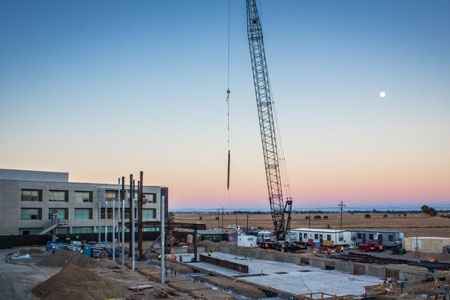
The University of California, Merced, has directly invested more than $1.1 billion into the San Joaquin Valley economy since the newest UC campus began start-up operations in July 2000, according to the campus’s Division of Business and Administrative Services.
The investment total represents an increase of $155 million over the past 12 months, the university reported. It includes the cumulative value of all wages and benefits paid, construction contracts awarded, and goods and services purchased within the San Joaquin Valley through August 2014.
 Statewide, the university’s direct investment total now surpasses $2.2 billion.
Statewide, the university’s direct investment total now surpasses $2.2 billion.
Because each dollar invested typically generates two to three times as much in indirect economic expenditure (the “multiplier effect”), according to recent studies commissioned by the UC Office of the President, the university’s total economic impact in the region and across the state is substantially larger.
“One of the primary objectives of locating a major new UC research university in the San Joaquin Valley was the much-needed economic growth and diversification it was expected to bring to the region,” UC Merced Chancellor Dorothy Leland said. “This latest set of investment data confirms that UC Merced is having a significant and growing impact on the region’s and state’s economic vitality.
“We begin our 10th academic year this fall with our largest-ever student enrollment and plans to expand physical capacity as rapidly as possible,” she added. “While much remains to be done to reverse the recession’s devastating effects on this part of the state, we are delighted to see the growing contributions our operations, our employees and our students are making to the recovery.”
Student enrollment this fall is at 6,268, up from 875 in the university’s inaugural year of 2005. The campus remains on track to enroll 10,000 students by 2020. To accommodate growth, major new facilities are planned both on campus and in downtown locations, such as the recently acquired .85-acre parcel at 18th and N streets.
Faculty and staff employment now totals more than 1,800 people, with part-time student employees adding nearly 1,100 more jobs. Most live, dine and shop within the region, stimulating additional growth and investment in the Valley by businesses and commercial establishments. Some recent graduates have opened new businesses, such as restaurants and services that appeal to the growing student population and local residents alike.
Faculty research activities also generate significant economic investment in regional goods and services. Research expenditures totaled more than $19 million in the past 12 months, bringing the cumulative total to $126 million since 2000.
“These direct research expenditures are often just the tip of the iceberg,” Leland said. “In the long run, the inventions, innovations and entrepreneurial spinoffs they tend to generate typically far outpace the initial dollars invested.”






